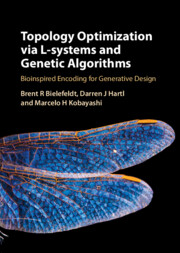 Topology Optimization via L-Systems and Genetic Algorithms
Topology Optimization via L-Systems and Genetic Algorithms Published online by Cambridge University Press: 13 June 2025
To place the proposed bioinspired approach in the proper context, this chapter provides a review of the topology optimization problem and a general overview and demonstration of existing topology optimization techniques. Four different classes of methodologies are discussed: (1) pixel/voxel representations, (2) ground structure-based representations, (3) boundary representations, and (4) emerging methods. For each class, we consider both the established approach and, if applicable, any extension(s) to the established approach or new methodology that utilizes the same underlying principles; each method is demonstrated using a common structural optimization problem, allowing for direct comparison. Where possible, we offer observations regarding the strengths and weaknesses of each approach and recommendations as to how and where each approach should be employed.
To save this book to your Kindle, first ensure no-reply@cambridge.org is added to your Approved Personal Document E-mail List under your Personal Document Settings on the Manage Your Content and Devices page of your Amazon account. Then enter the ‘name’ part of your Kindle email address below. Find out more about saving to your Kindle.
Note you can select to save to either the @free.kindle.com or @kindle.com variations. ‘@free.kindle.com’ emails are free but can only be saved to your device when it is connected to wi-fi. ‘@kindle.com’ emails can be delivered even when you are not connected to wi-fi, but note that service fees apply.
Find out more about the Kindle Personal Document Service.
To save content items to your account, please confirm that you agree to abide by our usage policies. If this is the first time you use this feature, you will be asked to authorise Cambridge Core to connect with your account. Find out more about saving content to Dropbox.
To save content items to your account, please confirm that you agree to abide by our usage policies. If this is the first time you use this feature, you will be asked to authorise Cambridge Core to connect with your account. Find out more about saving content to Google Drive.